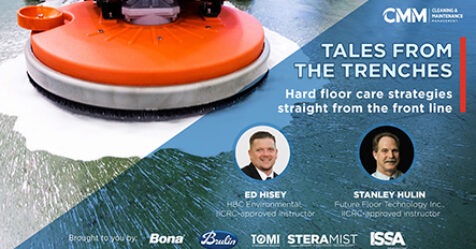With more than 30 years of experience, North Carolina State University (NCSU) Housekeeping Department staff have encountered many challenges in maintaining hard floors at the university’s campus in Raleigh. Staff members have maintained terrazzo, vinyl composition tile (VCT), sheet vinyl, slate, marble, polished concrete, epoxied concrete, ceramic, and stone. No matter what type of floor surface they are cleaning, all agree the maintenance of hard floors is crucial.
Hard floor maintenance tips and common errors
Dust and dirt have the potential to cause discoloration of hard floors, especially in high-traffic areas. It is important “to sweep and mop hard surface floors on a daily basis to prevent the floors from becoming dull,” floor care supervisor Clifford Ababio says. Floor technician Martin Taylor emphasizes the need “to strip and wax properly, spot mop with neutralizer, and scrub and buff once a week using proper equipment and neutralizer.” Deputy assistant director Taft Waldon says the best method he has found involves honing the floors with diamond-impregnated disks, followed by polishing with diamond-impregnated burnishing pads and applying a floor protectant against stains.
The staff have seen many common hard floor maintenance errors during their careers. They advise against:
- Not sweeping or dust mopping floors prior to wet mopping or auto scrubbing
- Refusing to use floor signs
- Using the wrong cleaning solution for the type of floor
- Using improper pads when burnishing.
Product evolution
Hard floor care products have changed over the past 10 years with a shift toward safer products that are less harmful to both people and the environment. Products no longer contain ammonia; harsh, toxic sealers; and strong odors. Taylor explains these improvements have reduced the negative effects on those who use these products, especially those with allergies.
Due to COVID-19, the deputy assistant directors are researching microban-fortified products as well as equipment developed for floor finishes and processes that have a residual kill claim
against viruses.
Ergonomic and environmentally friendly equipment also has improved hard floor maintenance over the years. “Equipment is now designed with the user in mind to help prevent a lot of the chronic health issues,” Waldon says. Ababio adds, “The introduction of green products like high-biodegradable floor maintenance pads and cordless stripping machines” are other examples of improvements.
Equipment preferences
Naturally, the team shares a preference for equipment that helps them meet the challenges of maintaining hard floors while saving time, money, and labor such as walk-behind and ride-on scrubbers. “The walk-behind scrubber, combined with a good neutral cleaner, is great for general maintenance,” floor technician Tory Harrison says. Floor technician William Lawrence and Taylor both prefer a nonchemical machine that uses water, which they say does a good job when stripping floors, has no harsh smell, is easy to use, and cuts time.
Ababio prefers a backpack wax applicator and cordless stripping machines. “The wax applicator can cover a vast area better than the old string mop method,” he says. “The dry stripping machine is also faster and can produce more output than the old system of using side-by-side.”
Waldon prefers orbital scrubbers, which can perform multiple floor tasks including chemical-free stripping and scrubbing because “they severely cut floor maintenance costs by significantly reducing man-hours and chemicals, allow for stripping during operational hours, and they don’t produce the strong smell normally associated with the stripping process.”
Data use for improvement
Databases are important to capture information about hard floor care projects. To do this at NCSU, facility planner Mat Trickel developed the Floor Maintenance Tool in 2017 and implemented it in 2018. The tool highlights under- and over-serviced spaces, records floor maintenance services, provides statistical data for estimating material and labor costs, and manages assigned floor maintenance services more effectively. Additionally, the annual renewable building data provides refreshed accuracy, providing sustainability.
Trickel says that the tool provides productivity and efficiency by “preventing duplicated services, measuring employees’/department’s annual productivity levels, [showing] accountability for floor maintenance expenses, and monitoring cost and expenses at all levels to cut waste and boost efficiency.” All the floor techs at NCSU have welcomed and appreciate this tool.
Next time you notice a well-maintained hard floor, remember the dedicated floor technicians like those at NCSU who make the floors shine and pop throughout the custodial industry.




